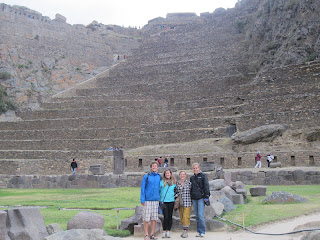The circumference of the Earth is 40,075 km. I am currently endeavoring to see as much of it as possible.
29 November 2011
28 November 2011
Cusco, Peru: Climbing and Ollantaytambo
 |
After the climbing adventure, we all walked back to Cusco through a windstorm, then the kids went back to Oropesa and I went to a three-hour salsa class. Dancing certainly is good exercise! |
 |
| The four of us by the sun gate, the sacred entrance to the Temple of the Sun in Ollantaytambo. |
 |
The terraces, the storehouse hill, and the current city stretched out in the valley below. |
25 November 2011
Cusco, Peru: A Pseudo-Thanksgiving
23 November 2011
Cusco, Peru: Azul Wasi, The Blue House
21 November 2011
Cusco, Peru: Let the Classes Begin
20 November 2011
Cusco, Peru: Goodbye, Dad and Hello, Family
 |
| Dad exploring one of the Inca parts of the Koricancha. |
 |
| A few more errands and some lunch, and then it was time to send Dad off! Thank you so much for coming, Dad...I had a blast! |
19 November 2011
Cusco, Peru: The Salkantay Trek to Machu Picchu
 |
| Because it started raining again once we got back from the lake, we camped under this shelter, which meant we were warm and dry while we rested up for day two. |
 |
| Because we were near the river, there were also a lot of feeder waterfalls. Here is one that Dad and I took a rest at along the way. |
 |
| ...we got to watch the sun rise over this 500-year-old city before any of the 2,500 daily visitors arrived. It was truly amazing to be one of only a few in this ancient place. |
 |
| Sitting on one of the terraces that the Incas grew potatoes in on the top of Huyana Picchu, contemplating the 700m-drop into the canyon below. |
 |
| In the course of exploring the city atop Huyana Picchu, we had to crawl through caves... |
 |
| ...and climb backwards down tiny steps. It was a bit scary at times, but it was totally worth all the climbing! |
 |
| When we got back down to the bottom, there was only one mountain left to conquer: the comparatively small Huchuy Picchu. This is Dad on a ledge, halfway up the 100m-or-so climb. |
 |
| After Huchuy Picchu, we had to make our way through the city one last time. This is me in the boys' school. |
 |
| Here is Dad near the still-working 500-year-old aqueducts. |
14 November 2011
Cusco, Peru: Incan Textiles, Moray, and Maras
 |
| ...but when you are climbing down into it (these stones were built in to the walls by the Incas as access routes)... |
 |
| ...you realize how large this experimentation station actually was! |
 |
| Climbing back out was good practice for our hike tomorrow, too--the elevation at the top of this site was just over 14,000 ft. |
 |
| Unlike anything either of us had ever seen, the salt flats were a great end to our day. After one harrowing car ride back to Cusco, it was time to pack and energize...because tomorrow, we hike! |
Subscribe to:
Posts (Atom)






































